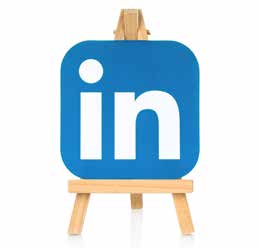Amazon CEO Jeff Bezos'Secret To Avoiding Email Overwhelm

Do you look at your inbox and want to cry? If so, you’re not alone. According to widely cited Radicati Group research, the average person gets 120 business emails every day. If you don’t manage your emails, you could end up in another statistical majority. People spend at least 14 percent of their workday on email alone. Is it any wonder that a recent Harris Poll found that only 45 percent of our workdays are spent on actual work? If you’re looking for the solution to your email woes, start with some of Silicon Valley greats.
BEZOS DELEGATES
If you want to watch a corporate team start to sweat, see what happens when they get a “?” email from Jeff Bezos. Business Insider reports that the notoriously easy-tocontact Amazon CEO will forward customer complaints to his people and add only a question mark to the original query. Getting that dreaded mark is a little like getting the black spot from Blind Pew the pirate. You know that a day of reckoning is at hand. Follow Bezos’ lead. Instead of answering all emails yourself, ask, “Can this be better handled by someone else?” Forward it to your team and save yourself the time.
USE AUTO REPLIES
You can also use auto-reply tools to manage the flood. Tommy John CEO Tom Patterson did just that after his emails skyrocketed from 150 to 400 a day. He tells Inc.com that "there weren't enough minutes in a day to answer all of them.” So he didn’t; he set up an autoreply to tell people that he only checked email before 9 and after 5 — and to please call or text if it was urgent. The result? “It forced me to delegate and empower others to respond,” he says. Suddenly the flow slowed to a trickle.
DO YOU GET MORE EMAILS THAN BILL GATES?
And it really should only be a trickle; Bill Gates reports that he only gets 40–50 emails a day. Ask yourself, “Should I really be getting more emails than Bill Gates?” One possible cause for email inundation, according to LinkedIn CEO Jeff Weiner, is other employees sending too much email of their own. He writes, “Two of the people I worked most closely with ended up leaving the organization within the span of several weeks. After they left I realized my inbox traffic had been reduced by roughly 20–30 percent.” If you have overcommunicators in your ranks, ask them to tone back the digital flood.

SET BOUNDARIES
Creating a hard buffer between your email and your life is another CEO tactic. Arianna Huffington doesn’t check her email for a half hour after waking or before going to bed, and she never touches it around her kids. That space to breathe is essential to maintaining a work-life balance. And if it gets bad enough? Etsy’s Chad Dickerson has a solution: email bankruptcy! He tells Fast Company that every few years, he just deletes everything and starts fresh!
Not all Silicon Valley gurus have it figured out, however. Apple CEO Tim Cook doesn’t get 120 business emails a day. No, according to an ABC interview, he gets closer to 700. He just gets up at the crack of dawn every morning and starts reading. Hint Water CEO Kara Goldin does the same thing, preparing for a 12-hour workday with a marathon email session. But as you can tell from the other people we’ve discussed, this is an exception, not the rule. Emulate Jeff Bezos or Arianna Huffington instead and watch your email stress melt away.
Free Report Download: The Business Owner’s Guide to IT Support Services and Fees

You will learn:
- The three most common ways IT companies charge for their services and the pros and cons of each approach.
- A common billing model that puts ALL THE RISK on you, the customer, when buying IT services; you’ll learn what it is and why you need to avoid agreeing to it.
- Exclusions, hidden fees, and other “gotcha” clauses IT companies put in their contracts that you DON’T want to agree to.
- How to make sure you know exactly what you’re getting to avoid disappointment, frustration, and added costs later on that you didn’t anticipate.
Claim Your FREE Copy Today at www.thewrightchoice.com/itbuyersguide.
Maximizing New Media

Strengthen Your LinkedIn Profile to Win New Business
If your LinkedIn profile isn’t engaging, you’re missing out on opportunities to be seen and heard. LinkedIn Groups are an opportunity to connect with people in your industry, share and receive content, and build relationships that grow your business. To find communities, select “Groups” from the LinkedIn search categories and enter a relevant keyword or phrase, and then join groups that are most relevant to you and your customers.
Geoff Smart: The 3 Hardest Questions
About Your Career

I love helping people strategize about their career. A recently retired governor just contacted me to schedule a career strategy chat. I’m guessing he has a sense of what he wants to do next, but needs a sounding board in order to come up with a plan.
I hope that my approach (described below) will not only be useful for him, but also for you. It starts with answering these three hard questions:
1. What is my skillwill bull's-eye? Your skills (what you can do) and your will (what you want to do) line up in what Randy Street and I call the “skill-will bull's-eye.” I recently helped a Fortune 500VP find hers when she struggled to put her finger on her core talents and interests. Was it head hunting? “No.” What about coaching? “I don’t think so?” What about designing the process that businesses use to recruit? “YES! That is what I get to do only part of the time in my current job. That is what I want to do with more of my time.” Presto — a skill-will bull's-eye!
2. What are three career paths? Force yourself outside the box by outlining three different career options. Following from the previous example, that VP had only previously focused on a corporate path. That was Path 1, so I asked what were two other paths she could consider. “Well, I guess Path 2 would be to try to join an existing consulting firm … and Path 3 could be that I hang out my own shingle and do that kind of work solo.” We discussed the pros and cons of each path, and she eventually chose Path 2.
3. Who are 10 people who can help me get my dream job? Do you know “hundreds of people?” Great, but let’s prioritize the 10 most likely to get you your dream job. Start by listing past bosses who know your work and are wellconnected. Now list clients or customers who respect you. Next, add a college friend or two with connections. Then a good recruiter, followed by any powerful family friends you may have. Once you have your 10, write out a half-page message summarizing the career path you’re looking for and the reasons you’d be a good fit for that path. End by asking for a few minutes of their time to pick their brain — minutes that will hopefully end in referrals to your dream job.
If you think these tactics are useful, please download our other free career strategy tools at geoffsmart.com/smarttools.

Dr. Geoff Smart is the No. 1 thought leader on the No. 1 topic in business: hiring and leading talented teams. Dr. Smart founded the leadership consulting firm ghSmart in 1995, a firm he still chairs today. He is also a nonprofit founder, government advisor, and Wall Street Journal best-selling author
SHINY NEW GADGET OF THE MONTH:
The Feeder of the Future

Petnet is looking to upgrade pet care with their new automated SmartFeeder, targeted toward pet owners who frequently travel or those with packed, variable schedules.
After you install the SmartFeeder app on your phone, it’ll ask a few questions to get to know your animal, including their age, weight, activity level, and food type. This last feature is particularly interesting, as the feeder will recommend feeding amounts for dozens and dozens of common cat and dog foods, though users report it can be a little finicky.
After it gathers the information, you can set up regular, automatic feeding schedules for your furry friend. After that, it’s an almost entirely hands-free process, until you need to reload the feeder with your animal’s preferred food.
Its $150 price tag may be a little steep for most pet owners, but for the busiest — and laziest — of us, it could be the perfect addition to your already-automated home.
Empowering Your Employees
According to several studies, a trusting work environment that allows flexible schedules — personalized work hours, remote work, or compressed workweeks — breeds more loyal employees and increases efficiency.
Researchers found that employees who were on a flexibility program were happier and less prone to burnout and psychological stress. Stanford professor Nicholas Bloom found that working remotely increases productivity, overall work hours, and employee satisfaction.
When we give employees control over where and when they work, it has a positive impact on productivity and company well-being.
This Genius Debit Card Lets Parents Control Their Teenagers’ Spending

If you feel like your teen views you as a walking ATM machine, startup company Current might be able to help. Their new app — also called Current — allows you to track and control your teen’s spending through the company’s debit card. Current offers a series of robust services designed to teach your child financial responsibility while still letting them have some say over how and when they spend their money. You can set up daily spending and withdrawal limits, but you can also set up contingencies — money that’s freed up, say, when chores or tasks are completed.Techcrunch.com 5/9/2017
You Won't BELIEVE Where Hackers Are Hiding Malware Now
If you use Popcorn Time or VLC, listen up: Hackers are targeting your subtitles. Yes, that’s right — from bad kung fu movie dubs to the latest and greatest European cinema, this technique hides malware in the downloaded subtitle information for a movie. Once it’s in your computer it takes root and communicates with the attacker. By the intermission, your machine belongs to them! If you’re a Popcorn Time user, you can download the patch online. VLC and other media players should have the problem patched by the time of printing. Or, you know, you could just not download movies from the internet … but we all know how likely that is. Techcrunch.com 5/24/2017
How a University Campus Is Using This New Technology to Keep Its Students Safe
Remember when you got locked out of your dorm building back in college and had to wait for someone to go in or out? Those days may be gone, if new technology out of China has anything to say about it. Dorms at Beijing Normal University are being fitted with face recognition software, which will let residents in — and keep intruders and other unwanted people out. Mashable.com 5/23/2017
Cartoon of the Month





